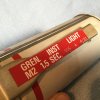British Ordnance Collectors Network
You are using an out of date browser. It may not display this or other websites correctly.
You should upgrade or use an alternative browser.
You should upgrade or use an alternative browser.
South African Illumininating grenade
- Thread starter roller63
- Start date
10135556
Member
Good afternoon,
It is the illumination grenade as issued to South African Security forces, & manufactured by Swartklip.
This grenade is designed to be thrown by hand. It produces a luminous intensity of 20000 candles minimum, with a duration of 30-40 seconds.
The grenade consists of a cylindrical body with two closing discs, there are two candles, seperated by a millboard washer. The two candles are connected by igniter cord.
These grenades have been discontinued due to its size as well as its mixture composition. It was replaced with a solid grenade.
It would be advicable to remove the bottom plug & take out the two candles. These must be destroyed in open area that has no flammable substances in its area.
The container's markings are as follow:
Red filling ring - denoting pre 1983 & contains an active agent
PY05 - is the pyrotechnic filling code
165 - filled lot number
8/78 - monogram of filler & date (month/year) of filling
a /77 - monogram of assembler & year of assembly.
Hope that this helps you.
Barry Higgs
It is the illumination grenade as issued to South African Security forces, & manufactured by Swartklip.
This grenade is designed to be thrown by hand. It produces a luminous intensity of 20000 candles minimum, with a duration of 30-40 seconds.
The grenade consists of a cylindrical body with two closing discs, there are two candles, seperated by a millboard washer. The two candles are connected by igniter cord.
These grenades have been discontinued due to its size as well as its mixture composition. It was replaced with a solid grenade.
It would be advicable to remove the bottom plug & take out the two candles. These must be destroyed in open area that has no flammable substances in its area.
The container's markings are as follow:
Red filling ring - denoting pre 1983 & contains an active agent
PY05 - is the pyrotechnic filling code
165 - filled lot number
8/78 - monogram of filler & date (month/year) of filling
a /77 - monogram of assembler & year of assembly.
Hope that this helps you.
Barry Higgs
Does anyone have some better pictures of this grenade?
Joe
Joe
Photos of an R2M3 Instant Light that I owned previously. (Empty, inert, FFE)
Note that the 3 in R2M3 appears to be an alteration.
Note that the 3 in R2M3 appears to be an alteration.
Attachments
-
 E33FB14C-D24E-4719-9328-959C4E76DA14.jpg241 KB · Views: 26
E33FB14C-D24E-4719-9328-959C4E76DA14.jpg241 KB · Views: 26 -
 F371DEA1-46CE-4CE4-873C-6F78053F7378.jpg198.5 KB · Views: 17
F371DEA1-46CE-4CE4-873C-6F78053F7378.jpg198.5 KB · Views: 17 -
 A1E8E375-B33F-459D-BAA9-B3B68EA9EA03.jpg233.6 KB · Views: 16
A1E8E375-B33F-459D-BAA9-B3B68EA9EA03.jpg233.6 KB · Views: 16 -
 36D31E01-F4BE-4602-8F90-59155759DF7C.jpg191.9 KB · Views: 16
36D31E01-F4BE-4602-8F90-59155759DF7C.jpg191.9 KB · Views: 16 -
 CD5E57B7-EF61-4829-84B0-1B36824E54F6.jpg259.9 KB · Views: 17
CD5E57B7-EF61-4829-84B0-1B36824E54F6.jpg259.9 KB · Views: 17 -
 78502DCB-0CCA-41AD-B4CE-E10A9462613B.jpg275 KB · Views: 18
78502DCB-0CCA-41AD-B4CE-E10A9462613B.jpg275 KB · Views: 18
Photos of the R2M3 Instant Light in my collection. (Empty, inert, FFE)
Note that the marking PY 05 appears to be an alteration.
Note that the marking PY 05 appears to be an alteration.
Attachments
-
 67080B79-E5DD-49EC-BEE2-EB8415BB4EEE.jpg262.9 KB · Views: 26
67080B79-E5DD-49EC-BEE2-EB8415BB4EEE.jpg262.9 KB · Views: 26 -
 D34F6D51-C94D-416C-B0CB-8E1EBB32F553.jpg251 KB · Views: 16
D34F6D51-C94D-416C-B0CB-8E1EBB32F553.jpg251 KB · Views: 16 -
 2C785589-A856-44B8-984D-150ED2694BE1.jpg272.4 KB · Views: 15
2C785589-A856-44B8-984D-150ED2694BE1.jpg272.4 KB · Views: 15 -
 410E81E9-7505-4505-AF1D-3E24B7B4B37C.jpg177.1 KB · Views: 14
410E81E9-7505-4505-AF1D-3E24B7B4B37C.jpg177.1 KB · Views: 14 -
 A4A7B1A5-D52F-42D0-83D9-6994C5F03216.jpg288.3 KB · Views: 13
A4A7B1A5-D52F-42D0-83D9-6994C5F03216.jpg288.3 KB · Views: 13 -
 A499C599-DA7E-4458-9576-6E83EC113F69.jpg289.9 KB · Views: 16
A499C599-DA7E-4458-9576-6E83EC113F69.jpg289.9 KB · Views: 16
Another question:
So the PY and SR are Pyrotechnic filling codes. Are those the factory filling codes? And if so what factories are they?
Joe
So the PY and SR are Pyrotechnic filling codes. Are those the factory filling codes? And if so what factories are they?
Joe
Joe,
British pyrotechnic compositions were/are prefixed by one of the three, two letter groups: PN, SR or RD. These letters originate from the bodies responsible for their design.
PN - Porton Number (invariably smoke compositions)
SR - Superintendent Research (invariably pyrotechnic compositions other than smokes but there are a small number of smokes)
RD - Research Department (the vast majority of RD compounds/compositions are sealants and kindred. However, there are RD fuze powders and propellants)
SR 547 - Appears to be of the 'flare' family, developed before WWII. An unofficial list of ingredients is - Magnessium powder, Lithographic varnish, Sodium Nitrate & Calcium Oxalate.
I would imagine 'PY' is a South African designation that has replaced the British compositions.
TimG
British pyrotechnic compositions were/are prefixed by one of the three, two letter groups: PN, SR or RD. These letters originate from the bodies responsible for their design.
PN - Porton Number (invariably smoke compositions)
SR - Superintendent Research (invariably pyrotechnic compositions other than smokes but there are a small number of smokes)
RD - Research Department (the vast majority of RD compounds/compositions are sealants and kindred. However, there are RD fuze powders and propellants)
SR 547 - Appears to be of the 'flare' family, developed before WWII. An unofficial list of ingredients is - Magnessium powder, Lithographic varnish, Sodium Nitrate & Calcium Oxalate.
I would imagine 'PY' is a South African designation that has replaced the British compositions.
TimG
Last edited:



